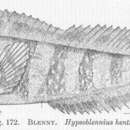Diagnostic Description
provided by Fishbase
Gill opening extending ventrally to opposite 7th-11th pectoral-fin ray; segmented dorsal-fin rays 13-16; segmented pelvic-fin rays 3; last dorsal-fin spine 8.5-15.5% SL; dorsal-fin spines robust and stiff; no elongate fleshy flap present posteriorly on lower lip; infraorbital bones 5-5; upper lip without free dorsal margin extending around snout; fleshy lobes of lower lip almost linear in lateral view and separated anterioventrally by a broad smooth area; bony interorbital width comparatively wider; dark spot usually present in spinous dorsal fin and centered on second spine; mandibular pores 4.
Life Cycle
provided by Fishbase
Oviparous, distinct pairing (Ref. 205).
Morphology
provided by Fishbase
Dorsal spines (total): 1113; Dorsal soft rays (total): 1316; Analspines: 2
Trophic Strategy
provided by Fishbase
Inhabits oyster reefs and rocky shores (Ref. 7251).
- Recorder
- Grace Tolentino Pablico
Biology
provided by Fishbase
Adults inhabit oyster reefs and rocky shores. Oviparous. Eggs are demersal and adhesive (Ref. 205), and are attached to the substrate via a filamentous, adhesive pad or pedestal (Ref. 94114). Larvae are planktonic, often found in shallow, coastal waters (Ref. 94114).
Importance
provided by Fishbase
fisheries: of no interest
Hypsoblennius hentz
provided by wikipedia EN
- license
- cc-by-sa-3.0
- copyright
- Wikipedia authors and editors
Hypsoblennius hentz: Brief Summary
provided by wikipedia EN
Hypsoblennius hentz, commonly known as the feather blenny, is a species of combtooth blenny found on coral reefs in the western Atlantic Ocean. This species grows to a length of 10 centimetres (3.9 in) total length. The feather blenny is found from Nova Scotia, Canada to Texas along the shore of North America. Often, feather blennies can be found in oyster reefs and rocky shores. The identity of the person honoured in this species' specific name is uncertain but it is thought that to have been the French American arachnologist Nicholas Marcellus Hentz (1797-1856) who is the "Mr Hentz" from Charleston, North Carolina who sent the type to Lesueur.
- license
- cc-by-sa-3.0
- copyright
- Wikipedia authors and editors
Distribution
provided by World Register of Marine Species
Western Atlantic: New Jersey (occasionally Nova Scotia - Shelburne Hbr, 43o41'N, 65o20'W, thus GoM - in Canada) to Texas, including southern Florida
North-West Atlantic Ocean species (NWARMS)
- license
- cc-by-4.0
- copyright
- WoRMS Editorial Board
Habitat
provided by World Register of Marine Species
Inhabits oyster reefs and rocky shores.
North-West Atlantic Ocean species (NWARMS)
- license
- cc-by-4.0
- copyright
- WoRMS Editorial Board
Habitat
provided by World Register of Marine Species
benthic
North-West Atlantic Ocean species (NWARMS)
- license
- cc-by-4.0
- copyright
- WoRMS Editorial Board

